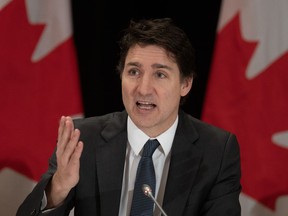
Article content
A major problem with evaluating the effectiveness of Prime Minister Justin Trudeau’s $200-billion climate change plan involving more than 100 government programs is that the government keeps retroactively changing the historical record of Canada’s annual industrial greenhouse gas emissions.
Advertisement 2
Article content
Since the purpose of Trudeau’s plan is to reduce emissions, this record is key to determining if taxpayers are getting good value for money spent.
Article content
The government says retroactively changing the historical record of Canada’s emissions every year is due to improved methods of measuring them, both past and present.
But it results in a constantly moving goalpost with regard to the government’s climate targets.
This makes it difficult to compare one year of emissions reporting to the next, because a new set of figures going back decades replaces the one provided the year before.
To illustrate, the Trudeau government last week reported that Canada’s emissions in 2022 were 708 million tonnes (emission are reported two years after the fact), up from 698 million tonnes in 2021 and 686 million tonnes in 2020.
Article content
Advertisement 3
Article content
But in the same report last year, the government said emissions in 2021 were 670 million tonnes (not 698 million) up from 659 million tonnes in 2020 (not 686 million).
Recommended from Editorial
-

GOLDSTEIN: The carbon tax went up and so did Canada’s emissions
-

GOLDSTEIN: Trudeau was Teflon, now he’s Velcro
-

GOLDSTEIN: Trudeau’s climate plan makes no sense – according to Trudeau
This retroactive change in annual emission levels is also applied going back decades and is particularly important for 2005, the year on which the government bases its target of reducing emissions to at least 40% below 2005 levels in 2030.
This year’s report says emissions in 2005 were 761 million tonnes. Last year it said they were 732 million tonnes.
Using this year’s report, Trudeau’s 2030 target is 457 million tonnes of emissions (60% of 761 million tonnes), considerably less stringent than last year’s 2030 target of 439 million tonnes (60% of 732 million tonnes).
Advertisement 4
Article content
This year’s report says from 2005 to 2022 Canada’s emissions decreased by 7.1%.
Last year’s report said from 2005 to 2021 Canada’s emissions decreased by 8.4%.
Using either set of data from the last two years, this means the government is moving further away from its 2030 target, not closer to it.
Commenting on this year’s report, Environment Minister Steven Guilbeault said:
“The hard work of Canadians is paying off … Canada’s 2024 National Inventory Report confirms we have bent the curve, and emissions remain on a long-term downward track while we grow a clean, sustainable, and strong economy. Together, we are making steady progress, and it is imperative that we keep up the momentum.”
RECOMMENDED VIDEO
In fact, whatever happens in the long term – and those predictions are based on assumptions by the government that programs that haven’t started yet will be completed on time and work as predicted – in the short term emissions, according to the government’s latest data, are going up, from 686 million tonnes in 2020 to 698 million tonnes in 2021 to 708 million tonnes in 2022.
Advertisement 5
Article content
Guilbeauilt also said Canada’s emissions are the lowest in a quarter century, excluding the pandemic years of 2020 and 2021.
That’s a strange way of saying what has actually happened, which is that the only major drop in Canada’s emissions since the Trudeau government came to power in 2015 occurred because of the global recession caused by the pandemic starting in 2020.
That’s what “bent the curve,” not Trudeau’s climate change plan.
Emissions drop during recessions because there is less economic activity using fossil fuel energy.
In the modern era, emissions have only dropped dramatically twice in Canada – during the pandemic recession and during the 2008-09 global recession set off by the subprime mortgage derivative scandal in the U.S.
Advertisement 6
Article content
RECOMMENDED VIDEO
According to this year’s report by the Trudeau government, when the Liberals came to power in 2015 Canada’s emissions were 746 million tonnes.
They dipped to 731 million tonnes in 2016, then rose to 742 million tonnes in 2017, followed by 753 million tonnes in 2018 and 752 million tonnes in 2019.
That means at the conclusion of Trudeau’s first term in office in 2019, Canada’s emissions were six million tonnes higher than when he was elected in 2015.
While 2019 was the year Trudeau introduced his carbon tax, that wasn’t what dramatically lowered Canada’s emissions from 752 million tonnes in 2019 to 686 million tonnes in 2020.
That was the result of the pandemic recession which began in 2020.
It’s true, as Guilbeault says, that the intensity of emissions (the amount of emissions per unit of economic activity) has fallen under the Liberals, but it’s also been falling for decades.
The Liberals also argue emissions would have been higher had the Conservatives remained in power after 2015.
Article content



